Piotr Naskrecki's Blog, page 7
July 5, 2013
New life

The Transkei shieldback (Transkeidectes multidentis, 1992) was one of the first species that I described, based on a single specimen collected in 1947 near Port St. John’s in the Eastern Cape of South Africa. Describing a new species based on a single specimen is a horrible idea (you never know whether you might be dealing with an aberrant form of something already known), and ever since I have been looking for more individuals to confirm the existence of this species.

To my enormous relief, I have recently located a thriving population of the Transkei shieldback in the coastal forest of the Silaka Nature Reserve near Port St. John’s. The species is real.
Today marks the first anniversary of The Smaller Majority blog which, to my delight and surprise, has been steadily gaining readership. I am grateful to all who visited these pages over the last 12 months, especially those who kindly left the wonderful, insightful, occasionally snarky comments under many of the 130+ individual stories – keep’em coming! So far this blog has amounted to 75,000 words and 770 photos – that’s a decent size book; maybe I should have done that instead? Nah! And what better way to acknowledge the portent of this occasion than to talk about what I consider the most exciting aspect of my work as an entomologist – the discovery of new forms of life.
When I was about seven years old my father said something that, in retrospect, was probably the most important piece of information I have ever received, one that has influenced my entire life. I should mention that my father was an astronomer, and he did his best to try to entice me with his line of work, to no avail. (At some point he even built a telescope for me, but I only used it to watch birds and spy on my neighbors; I was a lost cause.) To my question about a possibility of finding life elsewhere in the Universe he replied that those chances were slim, but that our own planet still had many organisms that remained undiscovered and unnamed. That statement stopped me in my tracks. I instantly envisioned mysterious, dinosaur-like creatures hiding in the depths of African jungles. But he explained that the yet-unnamed animals were probably small, and that they might even be living in our own backyard. I am certain that at that very moment I decided to become an explorer who would spend his life questing for those elusive, undiscovered creatures. Of course, I did not realize then that most discoveries of new species take place among dusty drawers of museums, made by taxonomists whose lives are decidedly less than glamorous. But the stage for a career in entomology was set.

The Martian landscapes of the Northern Cape of South Africa, despite their foreboding appearance and extremely harsh conditions, are home to a number of very interesting orthopteroid insects.

My friend Corey Bazelet and I discovered the handsome, wingless katydid Brinckiella arboricola Naskrecki & Bazelet, 2009 in the Geogap Nature Reserve of Northern Cape.
It took me fifteen years to run into a beautiful little gem of a katydid in a meadow in Turkey, an animal that until then had eluded entomologists. I named it Poecilimon marmaraensis, after the Marmara Sea on the shores of which this species occurs. The elation of knowing that I was the first person on Earth to find it was intoxicating. I am sure that all my fellow taxonomists have felt it at some point in their lives, and for many it is the ultimate reward. Finding new forms of life is to me one of the greatest adventures in biology, one that the current biodiversity crisis makes a pressing necessity. Extinctions and the appearance of new species are natural phenomena that once were fairly well balanced, with speciation always slightly outpacing extinction and making Earth’s biodiversity increasingly richer. But with the advent of man, this balance started to tip dramatically toward extinction, and we now lose species at a rate a thousand times higher than the natural, “background” one. Regardless of being named or not, each species gone extinct is another book of genetic code burned, another piece of the intricate puzzle of life on Earth irreversibly lost. And while destruction of natural habitats and the alarming pace of species loss give little hope for preserving all the components of Earth’s biota for future generations, we should make every effort to document all organisms that still inhabit our planet. Still, on some days, the nagging pessimist in me points out that maybe all that we taxonomists do is carve names on tombstones and write obituaries for species who may be gone by the time their formal, scientific names are published. He may be right, but I hope he isn’t.
In spite of all the evidence that the world at large simply does not care about most of our non-human brethren, I still believe that armed with the complete knowledge of all Life on Earth we will be able to make the best decisions as to where conservation efforts should be focused, and that we will manage to save a very high proportion of the world’s phyletic diversity and biocomplexity. The more diverse Life is, the more stable and capable of self-regulation are its assemblages. The more species alive, the more likely we are to discover new medicines, new crops, or new structures worth imitating. The more Life we have around, the more our own is worth living.

Brown-faced spear bearer (Copiphora hastata Naskrecki, 2000) – This huge conehead katydid is common across Central America. Females of this and related species carry an enormous ovipositor that allows them to lay eggs at the base of litter-filled fronds of small palm trees.

The Costa Rican rainforest is home to about 350 species of katydids, many yet unknown, of which I have so far discovered and named a little over 50.

The Simandou Mts. blattodean (Simanoda conserfariam Roth & Naskrecki, 2003) is an insect that may be already extinct in the wild. I first found it in a cave in SE Guinea (West Africa), a place that was part of a large mining concession. Although mining operations in the Simandou were recently halted (presumably soon to be resumed), the cave was on the path of a major road that was being constructed and it may no longer exist.

I described the Agile grasshopper (Rhachitopis brachypterus Naskrecki, 1992) based on a small series of preserved specimens collected in Zimbabwe, but until recently have not seen a live individual. Such a situation is very common in entomology as most species are described using specimens from museum collections, often preserved tens or even over a hundred years earlier.

During the Cheringoma Plateau biodiversity survey in Gorongosa National Park, Mozambique, I crawled out of my tent one morning and the first insect I saw was my Agile grasshopper. Little compares to the joy of seeing for the first time a living individual of a species that you have described and named.

In addition to my work on insects, I have occasionally dabbled in arachnids. The Atewa dinospider (Ricinoides atewa Naskrecki, 2008) was an exciting discovery I made in SE Ghana.
[image error]
When it comes to yet undiscovered and unnamed species, Papua New Guinea is one of the richest places on the planet – nearly 80% of all species that I had collected there turned out to be new to science. One of them was the Ingrisch’s katydid (Ingrischia macrocephala Naskrecki & Rentz, 2010), which my co-author David Rentz aptly christened “a katydid designed by committee.”
Filed under: Arachnida, Grasshoppers, Katydids


July 2, 2013
Night callers

A male Lobosceliana cinerascens from Gorongosa National Park, Mozambique perched on the trunk of an Acacia.
At first I didn’t know what woke me up. The night was silent and nothing but a faint warble of tree crickets could be heard outside my tent. For a few of minutes I just lay there, foggily trying to figure out what disturbed my sleep but soon started to drift off. Suddenly, there it was again – a sharp noise, like some heavy machinery, right next to my head. The noise made me sit up and reach for the headlamp – it could only be one thing, and I wanted it. I slunk out of the tent, careful not to disturb the animal that was causing the ruckus. And there he was, sitting on a low hanging branch, a pamphagid grasshopper.

A female Hoplolopha sp. from the Northern Cape province of South Africa.
African members of the grasshopper family Pamphagidae, known in South Africa as the “rain locusts”, are a strange lot, even by the standards of a place that gave us heelwalkers and goliath beetles. For one, they are huge. The male Lamarckiana that woke me up in the middle of the Mozambican savanna during a recent survey of Gorongosa National Park was about 10 cm long, with a massive build of an animal whose only defense is to make itself impossible to swallow. He had long, leathery wings and his thick hind legs were covered with sharp spines. But aside from his size the most unusual thing about this grasshopper was the way he was calling. Firstly, he was doing it at one in the morning, which was way past bedtime for nearly all self-respecting grasshoppers. He was also doing it all wrong. Rather than rubbing his hind femur gently against the front wing, which is the typical grasshopper way of producing sound, he was kicking the wings violently with his hind tibia, aiming for a concave spot covered with dense, parallel ridges. The resulting sound was incredibly loud and mechanical, very different from the whispery stridulation of most grasshoppers. A friend of mine claims that he almost had a heart attack when a pamphagid grasshopper that I kept in our shared office suddenly started singing in the middle of the night – he was convinced that a spaceship was about to land outside the window. (Click here to listen to a recording of Hoplolopha sp. I made in South Africa – crank up the volume so that you can hear jackals calling once the grasshopper stops.)

A male Lamarckiana sp. from Richtersveld, South Africa. The inset shows the stridulatory area of the wings, which the male kicks with his hind tibia in order to produce sound.
African pamphagids, especially those belonging to the subfamily Porthetinae, exhibit a remarkable sexual dimorphism. In most species the males are fully winged and usually can fly quite well; often they are attracted to lights at night, causing consternation among people not used to the idea of a grasshopper the size of a small bird. Females of all Porthetinae are completely wingless and even larger than the males. Their body is also more heavily sclerotized and often covered with hard ridges and spines – a predator must be really desperate to try tackling one of these walking tanks. Surprisingly, despite the lack of wings, females are also capable of producing sound by rubbing their legs against the rough surface of the abdomen. The sound, which is much softer than that of the male, is used to startle potential predators; in some species immature individuals are also capable of such defensive stridulation.

A mating pair of Lobosceliana cinerascens from Zimbabwe.

Female Lamarckiana sp. from the Cheringoma Plateau of Gorongosa laying eggs in the soil. These animals are so perfectly camouflaged that even in this closeup photo it is difficult to discern the animal’s main body parts.
Filed under: Behavior, Cheringoma, Gorongosa, Grasshoppers, Mozambique


June 27, 2013
The miracle of parallel evolution

Herpetologists, can you tell which is which? Left: Centrolenella spinosa from Costa Rica, right: Hyperolius cf. pusillus from Mozambique.
I have been going through photos taken during a recent trip to Mozambique, and every now and then I am struck by the similarity of some of the African organisms to their counterparts on other continents. One of the best such examples is that of Neotropical glass frogs (Centrolenidae) and some African reed frogs (Hyperoliidae). Their resemblance to each other is uncanny – the two animals display a virtually identical, nearly translucent body, and only the shape of their toe pads reveals which is which. And yet these two lineages of frogs are separated by at least 150 million years of evolution, with many forms that look nothing like them in between, but ended up evolving the same, homologous morphology.*) These two groups differ quite significantly in their biology, however. The South and Central American glass frogs are forest animals, spending most of their life in the trees, often high in the rainforest canopy. They lay their eggs on the underside of leaves that hang over fast flowing streams. Males of these frogs often guard multiple egg clutches, until hatching tadpoles are washed off by rain into the stream below. The African “glass frogs”, members of the Hyperolius nasutus species complex and a few others, have a very different lifestyle, and are found in open, grassy areas of the southern part of the continent. They lay eggs underwater in big clumps attached to submerged plant stems, and exhibit no parental care.
Seems to me that parallel evolution is another argument against the existence of a magical intelligent designer – if the designer is intelligent enough to invent loa loa and the HIV virus, why are so many of its designs so incredibly repetitive? (I say “its” because if this omnipotence exists, I cannot imagine that it sports a set of male, or any other, genitalia.) If I could create anything, I would at least give some frogs laser eyes. Or make tiny dragons with wings. Oh, wait.

One distinguishing feature of true glass frogs is the position of their eyes, which point forward, giving them more human-like appearance.

African reed frogs, like this Hyperolius cf. pusillus from Gorongosa National Park in Mozambique, have more typical eyes, positioned on the sides of the skull.
*) Parallel evolution is different from convergent evolution in that in the former similar structures evolve independently but use homologous elements e.g., pterodactyl and bat wings, whereas in the latter similar solutions are developed by using unrelated, non-homologous elements e.g., shells of ostracod crustaceans and clams.
Filed under: Amphibians, Costa Rica, Frogs, Gorongosa, Mozambique


June 23, 2013
There is a fly in my car

Although the larvae of bluebottle flies (Calliphora vomitoria) feed on decaying flesh, adults are often attracted to flowers and feed on nectar.
“Honey, what died in my car?” I called my wife a few days ago, after the stench had become overwhelming. For a few days after returning from a long trip to Mozambique I had tried to pretend that the god-awful smell in my car was just a figment of my imagination. Alas, opening windows or cranking up the radio wasn’t helping, and it was time to face the reality. On the other end of the line my wife softly cleared her throat and in the tone of voice that I was hoping never to hear (“That kid of ours – your son – well, he isn’t yours”) she whispered “I kind of, sort of, hit a bird. He might have been sucked in under the hood.”
That explained a lot – the vile reek, the blowflies in my car. I decided to investigate it further, but found nothing. There was no decaying corpse stuck to the grill of the car, and no feathers anywhere I looked. And yet the stink was still lingering, and more and more flies were thrashing against the windows of my car.
I have nothing against blow flies. As a matter of fact, I like them a lot. One species of these insects, the greenbottle fly (Lucilia sericata), has recently become important in treating wounds infected with Methicillin-resistant Staphylococcus, especially in cases where antibiotic treatment or surgery are ineffective. Fly maggots applied to wounds help clean (debride) the dead tissue, speeding up recovery; they are also great at treating wounds infected with Gram-negative bacteria.
But the blow flies that were happily spawning inside my vehicle are known as the bluebottle flies, whose enchanting scientific name – Calliphora vomitoria – speaks volumes about both their appearance (in Greek “Calliphora” means “the one who carries beauty”) and lifestyle. I thought that they were pretty cool, but it was becoming difficult to breathe while driving, and the poor flies were desperate to find food and water, and I was getting slightly annoyed with them trying to obtain both ingredients from my eyeballs. Something had to be done.

A jumping spider (Phidippus audax) with its blowfly meal.
I followed my nose and zeroed in on the trunk of the car. Cringing in the anticipation of what I would find I gently lifted the lid, and a thick wall of funk hit my nostrils – the trunk was full of dog food. About 20 pounds of loose kibbles, originally dry but now wet and soggy, covered every surface. Now, some people say that processed food has little real animal protein in it, and that dog food is mostly ash and ground-up horse hooves, but the army of wiggly fly maggots in my car’s trunk proved them wrong. Bluebottle flies are carrion specialists, and if they found happiness in a pile of wet dog food that means that its animal protein content must be very high. It also must smell to them like a rotting corpse, which it certainly did to my unsophisticated, human olfactory organs.
I spent the next two hours scooping the dog food goo full of maggots from the car, spraying every surface with Lysos, vacuuming, and wiping. “Do you know anything about the dog food in the trunk?”, I inquired when I was done. “Oh, that thing”, my wife shrugged dismissively and walked away to tend her garden.
Filed under: Flies


June 20, 2013
Sweat the small stuff
Ground beetle (Anthia fornasinii) carrying a dead cicada. In South Africa these beetles are known under the charming name “oogpister” (“eye pisser”) on the account of their ability to squirt defensive chemicals from their abdomen straight into the eyes of potential predators.
Recently I have been processing some of the 18,000+ photos I took during a recent trip to Mozambique, and yesterday one image caught my eye. It shows a large ground beetle carrying a dead cicada. I shot it rather casually one night in front of my tent in Gorongosa, and immediately forgot about it. But now, looking at it closely, I realized that I was guilty of the very same thing that I often preach against – I did not pay enough attention to the small things, and missed an interesting detail. Zooming in on the photo I noticed several ants milling around the beetle’s feet. More interestingly, one of the tarsi had a dead driver ant (Dorylus) permanently attached to it – the beetle had survived an attack by these notoriously vicious insects, which was quite impressive. But what were the other ants doing? I guess I will never know. I have made the same mistake in the past, where I would notice something interesting about the scene that I had shot, but only when it was much too late to go back and photograph it again.
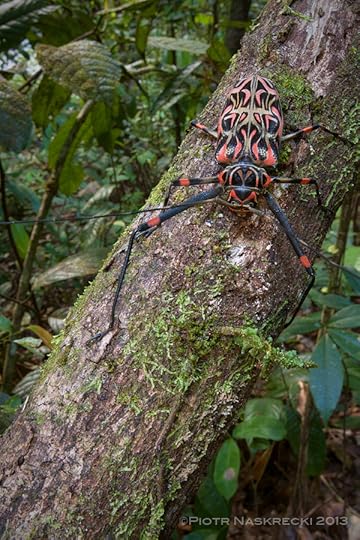
A female Harlequin beetle (Acrocinus longimanus) from Guyana. The body of this insect is a vibrant ecosystem for several species of arachnids.
But there is one thing that greatly helps in preventing this from happening – as Louis Pasteur succinctly put it, “In the field of observation, chance favors the prepared mind.” In the field of nature photography, the more you know about your subject, the more likely you are to notice something interesting or unusual, and refocus on that. My best example comes from Guyana, where a few years ago I found a gorgeous Harlequin beetle (Acrocinus longimanus). After taking a few photos of the animal I was about ready to let it go when suddenly some microscopically tiny object ran across its body. I felt a spark in my brain reignite some old, long unused synapses, and recollections started flooding in – “That looked like a small scorpion. No, a pseudoscorpion. They are phoretic. One species is found only on Harlequin beetles. Cordylochernes scorpioides, that’s it!”
Large fig trees in South American rainforests serve as hosts to the spectacular Harlequin beetle, which completes its larval development in the wood of these plants. The body of this giant insect is in itself a vibrant ecosystem for several species of smaller animals. Hundreds of mites hide under the wings and in crevices of the beetle’s body, using the insect as a convenient way to move from place to place. The mites also serve as food for another passenger, the pseudoscorpion. But the mites are not the main reason why pseudoscorpions embark on the beetle’s back.

A phoretic pseudoscorpion (Cordylochernes scorpioides) uses the body of the Harlequin beetle to move from one fig tree to another, and to find mating partners and food.
These arachnids spend their lives on the same fig trees that the beetles need to develop and where they seek mating partners, and thus the pseudoscorpions can be assured that by hitching a ride on a harlequin beetle they will end up on another tree of the same species. This also means that the beetle’s back is a great place to meet new partners who hopped on it to look for new fig trees to colonize, and a lot of sexual activity takes place among pseudoscorpions under the covers of the beetle’s wings. Some male pseudoscorpions never leave the beetle because they know that with each landing on a fig tree new females will embark, giving them more chances to pass on their genes. And because some time ago I had read a study that described all this, I did not miss the opportunity to photograph this fascinating symbiosis. Now, if only somebody wrote something about beetles and ants…

Phoretic mites on the body of a Harlequin beetle serve as food to pseudoscorpions.
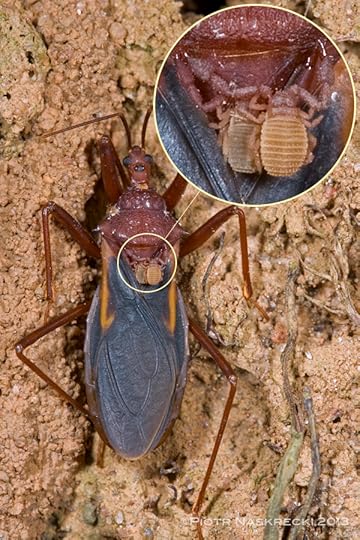
I missed this one – an African assassin bug from Guinea also has phoretic mites and pseudoscorpions, but I only noticed them while processing this photo. It is possible that their natural history parallels that of the Neotropical Harlequin beetle and its passengers.
Filed under: Arachnida, Beetles, Behavior, Gorongosa, Mozambique


June 17, 2013
Mozambique Diary: How to kill an assassin

The African assassin bug (Glymmatophora sp.) from Gorongosa, Mozambique
I often lament the fact that humans are freakishly gargantuan next to nearly all other animals, and thus unable to appreciate the beauty and complexity of the majority of smaller life forms that share the world with us. Yet, at the same time I am thankful that we do not need to contend with the likes of tiger beetles or solifugids, and that ambush bugs will never succeed in luring us into their deadly grip with their imitation of the sounds that humans make. Compared to even the most vicious and dangerous mammals, the world of arthropods is orders of magnitude more advanced in the art of killing – if a lion were to be shrunk to the size of an average insect it would last no more than a few minutes before being dismembered by the first praying mantis or a spider, who would laugh at its puny claws, soft and squishy body, and the complete lack of any real weapons.

The hunt begins –the assassin bug notices the millepede and begins to approach it.
And although I prefer to study the more peaceful aspects of invertebrate behavior, such as their courtship and love songs, I cannot help but be impressed by the sophistication of weaponry used by arthropods to kill, or exact revenge on those who try.
On my last night in Mozambique, when I should have been packing and getting some sleep before a long journey home, I suddenly realized that I had almost missed the opportunity to solve the mystery of how ectrichodiine assassin bugs hunt their favorite prey, the giant African millipedes. I had caught a beautifully metallic, wingless assassin bug (Glymmatophora sp.) a few days earlier, and now all I needed was its prey. Luckily, I was still in Gorongosa, where most biological questions can be answered by taking a slow walk and paying attention, and within a few minutes I managed to find a large millipede.

Without the millepede being aware of it, the assassin bug slowly crawls on top.
For a docile, seemingly harmless animal, millipedes (Diplopoda) have surprisingly few enemies. As is often the case among small animals, an innocent demeanor hides powerful and quite unexpected defensive strategies. Millipedes have two major lines of defense, both effective enough to deter virtually all predators. First, the chitinous base of their exoskeleton is composed of up to 70 percent calcium and magnesium carbonate, making it much harder than that of most terrestrial arthropods. Few predators are strong enough to crack it, although mongooses have been reported to toss millipedes against rocks to break their shells. For smaller predators such as spiders, the hard exoskeleton is an almost impenetrable barrier. But if one tries its luck anyway, a rich arsenal of chemical warfare stops the predator in its tracks, literally. Some millipedes produce substances that act as sedatives, forcing the spider into a state of suspended animation that lasts for many hours. Interestingly, this substance is virtually identical to the drug quaalude, a synthetic sedative once widely used in medicine and as a recreational drug. But licking millipedes to get high is not a good idea as many species produce cyanide, the most powerful inorganic poison known to man.

The assassin bug positions itself so that its rostrum can be inserted between the millepede’s legs.
Others exude substances that cause vomiting, headaches, and other unpleasant effects. And yet, few millipede species have warning coloration, which is typical of organisms that produce repellant chemicals. It is believed that the extreme effectiveness of their chemical weapons, combined with the very long time they have been around (terrestrial millipedes date back to the Carboniferous), made predators develop a genetically based aversion to these animals, and the millipede’s shape alone is a sufficient warning.

Once in place, the assassin bug delivers the deadly bite.
Assassin bugs (Reduviidae: Ectrichodiinae) are some of the very few animals that are able to hunt millipedes. They overcome the millipedes’ mechanical defenses by injecting them with a fast acting venom through a soft membrane between the calcified plates that cover their body. They also avoid being poisoned by their prey’s chemical defenses thanks to the way they feed – rather than chewing food, and thus potentially ingesting some of the toxic compounds, they inject their prey with digestive enzymes and then drink the liquified tissue through a long, sharp rostrum. All this is well known to biologists, of course, but surprisingly there exist very few documented observations of how the hunt unfolds, and what part of the millipede’s body is targeted by the assassin bug. On my last night in Gorongosa I had a chance to find out.

The assassin bug’s bite makes the millipede convulse and exude yellow droplets of toxic benzoquinones.
I placed the two animals on the white stage of my field photo studio and waited. After a few minutes the assassin bug noticed the millipede and started to approach it stealthily. With imperceptibly slow steps it climbed the millipede’s body and positioned itself almost upside down, with the head and rostrum facing the ventral side between the millipede’s legs. It was clearly aiming for the softest part of the body. And then, with an amazing speed, it pierced the millipede with its stiletto-like rostrum. The millipede’s reaction was dramatic – its body twisted and uncoiled like a spring, nearly sending it up into the air. After a few seconds the body relaxed, and yellow, acrid droplets started oozing from between its plates. This was the moment when the assassin bug decided to walk away.

After a few minutes the millipede is dead (but read the entire story to see what happened next).
I was already feeling bad for staging this drama, but the bug’s behavior made me feel even more guilty. “You ain’t going nowhere, buddy”, I thought as I placed a large container over the predator and its prey, “finish the job and eat it.” I simply could not understand why the assassin bug, which clearly must have been hungry, would suddenly abandon its dinner. And then, within a couple of minutes, the assassin bug was dead.
It all now made sense – the assassin bug was not abandoning its kill, it was just walking away to avoid being poisoned by the deadly benzoquinones dripping from the body of its victim. It would have undoubtedly come back to feed after the millipede had died and most of the volatile chemicals had blown away. By placing a container over the two animals I created a gas chamber that killed them both. I still feel awful about it but, alas, this is how biological mysteries are sometimes solved. I strongly suspect that the scent of benzoquinones, which are only emitted by an injured or dying millipede, acts as a long-range attractant to other assassin bugs that are often seen feeding communally on large millipedes, but at the same time the animal that made the kill must temporarily move away to avoid death from the same compounds. Aren’t invertebrates amazing?
Filed under: Behavior, Diplopoda, Gorongosa, Hemiptera, Invertebrates, Mozambique


June 13, 2013
Only in America

Only in America – both 13- and 17-year periodical cicadas are found mostly in the northeastern portion of the United States, with a few broods extending as far West as Kansas and as far South as Louisiana.
I first learned about the existence of periodical cicadas when I was a young boy, still living in z Old Country. The idea that an insect could develop underground for 17 years was crazy enough, but the fact that after all that time every individual within the population emerges at once in a synchronized, massive wave was almost too much to believe. Naturally, I became obsessed with this incredible phenomenon, which takes place only in the eastern half of the United States, and nowhere else in the world. To make it even more interesting, in addition to their unusual biology, these insects were reputedly quite tasty, thus combining my two greatest passions – entomology and exotic dining – into one, handy package. I very badly wanted to see them.

A nymph and an adult of a 17-year periodical cicada (Magicicada septendecim) from Meriden, CT.
My first opportunity came in 2004, when Brood X of the 17-year cicadas emerged in Washington DC and the surrounding states. Like the birds and dogs, which go crazy at the sight of such an unexpected bounty and stuff themselves with cicadas until they are ready to burst, I also went a little nuts. My friend Leeanne and I organized a cookout, daring others to try our fried, chocolate-covered, and roasted cicadas and, in the final stage of the entogastronomical orgy, live ones. Surprisingly, live, freshly molted (teneral) cicadas turned out to be absolutely delicious, combining a firm but yielding texture, with a creamy, delightfully nutty flavor. Now that I think about it, they might be considered a terrestrial equivalent of raw oysters. I wonder how they would taste with a drop of champagne mignonette and a touch of horseradish?

Nymphs of periodical cicadas spend 13 or 17 years underground, feeding on roots of trees. Their front legs are enlarged and perfectly adapted for digging.
The opportunity to find out may be at hand. This June, for the first time since 1996, 17-year cicadas (Brood II) are emerging in central Connecticut, and thus not too far from my home in Massachusetts. Yesterday I took a drive to Connecticut to see if I can score some of the beautiful and delicious insects. With friends Derek and Melissa we arrived at a particular street corner in Meriden, CT, which we had carefully selected based on the latest reports of cicada sightings. The first thing I noticed after stepping out of the car was the persistent hum of cicadas calling from high in the trees. There were clearly thousands of them in this neighborhood, and soon we started seeing small clusters of cicadas sitting on trees and bushes. Alas, they were all mature adults.

When finally ready to molt, cicada nymphs climb trees and other tall objects, and transform into beautiful adults. This individual is a member of the Brood X, which emerged in 2004.
To eat cicadas, one must collect them while they are still soft and lightly colored, before the chitin of their exoskeleton hardens and the wings fully expand. Still, it was great to be able to see these amazing insects again. Derek and I spent some time photographing the cicadas, although strong and gusty wind made it quite difficult. After my friends had left I stayed a bit longer, determined to find some teneral individuals. I did not find any, but after some digging in the soil I located cicada nymphs. I brought a few of them home, and now all I need to do is wait, and make some mignonette sauce.

Newly emerged (eclosed) periodical cicadas are almost snow white, but within a couple of hours their body darkens and their exoskeleton becomes hard.

An empty exuvia of a periodical cicada.

Adult periodical cicadas live for only a couple of weeks, and during this time they feed on juices of plants.
Filed under: Behavior, Hemiptera, Insects


June 11, 2013
When life gives you lemons
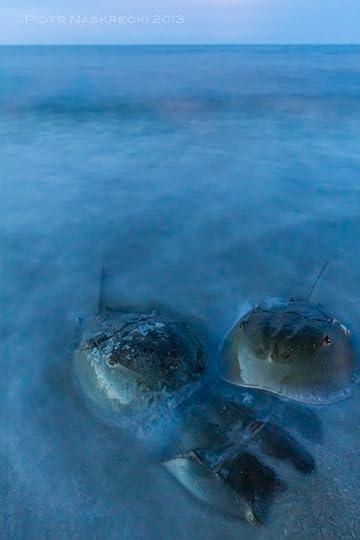
An 8 second exposure of mating horseshoe crabs (ISO 1250, 14mm, f 7.1) – I like these kinds of shots, but they give the false impression of the scene being static and dreamy.
Last weekend I drove with a couple of friends to Delaware to watch what surely must be one of the most amazing natural spectacles in North America, the annual mass spawning of Atlantic horseshoe crabs. I do it almost every year, and over time the eight hour drive from Boston to Delaware Bay has become a ritual, my way of communing with the ancient arthropods. (It is also an opportunity for me to gorge on delicious things I normally try to avoid – gas station donuts, Big Macs – after all, there is simply no way to eat healthily while on the road, right?)
A trip to Delaware allows me to flex my photographic muscles and try new approaches to capturing a scene that has been photographed a zillion times already, but this year the circumstances were not particularly favorable for photography. In fact, they could not have been worse. High tides, which is the time when horseshoe crabs emerge from the ocean to lay eggs, were late at night, long after the sun had set. It was new moon and the sky was overcast, hiding the stars. This challenge presented me with three possible options. I could forget about pictures and simply enjoy the show with a beer in my hand – I have already taken thousands of photos of horseshoe crabs, and didn’t really need to take any more. Very tempting. I could also shoot with flashes and get crisp, clinical shots of the crabs’ aggregations. Boring. Or I could think of a new, unorthodox way to shoot them.
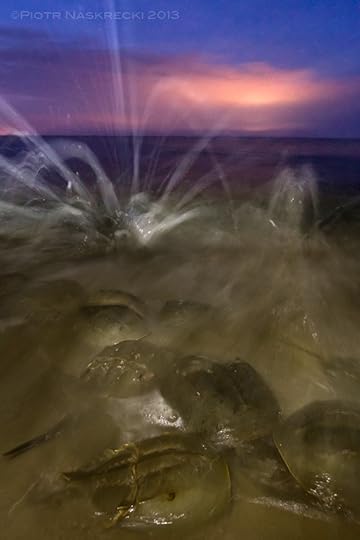
Once I used some fill-in light I was able to capture the true, dynamic character of the scene – waves crashing over the bodies of horseshoe crabs tumbling in the brown waters of the Delaware Bay.
Photographing horseshoe crabs is not easy even during the best of circumstances – the light is usually low, salt water splashes on the equipment, waves move the tripod. In the near darkness of the new moon things were even tougher. Still, I was determined to get at least one interesting shot. The idea was to capture the dynamic nature of the spectacle and convey the darkness of its surroundings. I decided to go for a low angle shot of the animals tumbling in the waves, while showing the darkening skyline. I used my Canon 7D with a Canon 14mm fisheye, mounted on a tripod (dug deep into the sand to stabilize it) and positioned less than a foot above the crabs in the splash zone. I had to wipe the camera and lens every minute, but soon they were both dripping wet. I tried a bunch of simple, long exposures (30 seconds or longer), but those produced static, if somewhat dreamy pictures, where the waves turned into a silky mist enveloping the animals. I needed extra light to capture individual waves.
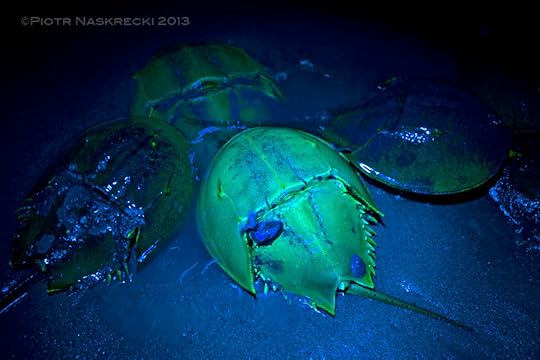
Horseshoe crabs, like some of their distant arachnid cousins, fluoresce under ultraviolet light. A dark, moonless night last weekend was a good opportunity to photograph it.
A pop of flash often works very well in such situations, freezing some of the action, while the rest of the exposure time allows for the scene to become more diffused and messy. But I did not like the harshness of the flash, and even my headlamp produced illumination that was too bright for a long, ISO 1600 exposure. Only after I wrapped it in a few layers of paper towels did the light become diffused and soft enough for me to start “painting” the scene with it. In the end I was able to capture an image very close to what I had in mind – a melee of animals among waves splashing against their bodies, while the last traces of sunlight reflect off the clouds above. The shot is grainy and dark, but to me it feels right and true to the circumstances. I guess the lesson here is that when life gives you lemons, you photograph them.

During the day, when horseshoe crabs were deep in the ocean, I photographed other things. Great Blue Heron hunting mud crabs in the marshes of the Prime Hook Nature Reserve made for an interesting subject.
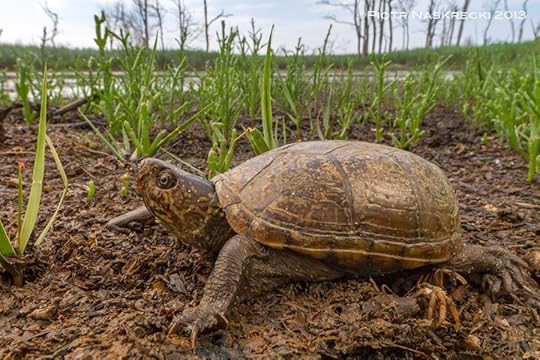
Natural areas surrounding the Delaware Bay are full of amazing creatures. I found this Eastern Mud Turtle (Kinosternon subrubrum) on a country road near the ocean.
Filed under: Behavior, Photo technique, Xiphosurida


June 6, 2013
BugShot 2013 in Belize
There are still a few slots available for BugShot 2013, a great opportunity to learn macrophotography in the rainforest of Belize from Alex Wild, Thomas Shahan, John Abbott, and yours truly. It is going to be a great event, at a fantastic location. You will not only discover the carefully guarded secrets of some of the best insect photographers in the world (e.g., what cameras they really use, how they drug their insects so that they sit absolutely still* etc.), but you will also learn a lot about insect biology and behavior, and visit a variety of Neotropical habitats.
Head on the BugShot.net to grab one of the few remaining spaces.
*) I am kidding, of course – real nature photographers never drug, chill, or kill their subjects.
[image error]
[image error]
[image error]
Filed under: Macrophotography, Photo technique


June 4, 2013
Mozambique Diary: Somebody has to clean this mess
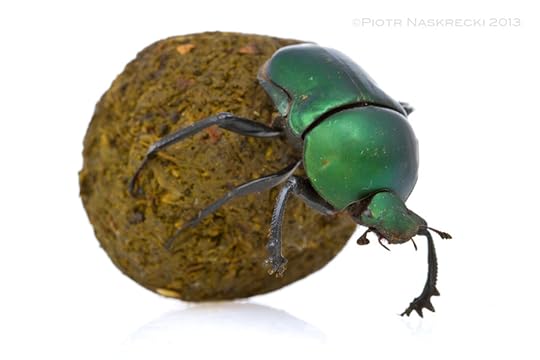
The Green dung beetle (Garreta nitens) is a pretty, diurnal species.
A friend of mine once compared holding a dung beetle in your hand to kissing a dog on the snout – both feel kind of good, until you think of the last thing they have probably been rubbing against. At least with dogs there is some room for other options, but there is no such ambiguity with the beetles. Still, it is difficult not to be impressed with the incredible forms and colors of these insects, and I had to constantly remind myself to be careful while handling the gorgeous dung beetle specimens that Bruno de Medeiros, a Harvard coleopterist participating in our Cheringoma biodiversity survey, kept bringing for me to photograph. For you see, the best and most effective way to collect these beetles is to lure them with a tasty bait. And there is no better bait than dung of an omnivorous mammal, and none is more omnivorous than a human. Dung beetle specialists have long been searching for the Holy Grail of Scarabaeology – a synthetic bait that attracts a wide variety of species – but, alas, they have not yet found it. And so, Bruno, like an expectant mother, was forced to eat for two (or rather several hundred) in order to produce enough bait to fill the dozens of pitfall traps needed to sample dung beetles at each of our survey’s sites.
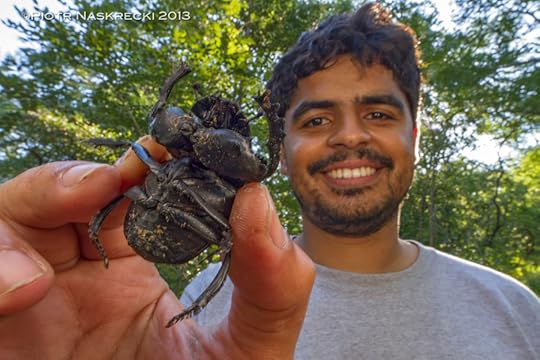
Bruno de Medeiros with one of the largest dung beetles found in Gorongosa, Pachylomerus femoralis.
We still don’t know how many species of dung beetles came to Bruno’s carefully baited pitfalls – identifying tiny aphodiines and other cryptic forms will take some time – but in his estimation at least 100 species, perhaps more, are to be expected. This is really good news for the Gorongosa ecosystem. Although the park lost a large proportion of its mammal population during the civil war of 1975-1992 and, consequently, its dung beetles surely must have suffered from the sudden decline in availability of their food resources, all original elements of their fauna are probably still in place. This means that as the large mammals return, and populations of most herbivores already show quickly accelerating growth rates, dung beetles will be able to build up quickly and resume their thankless but invaluable services.
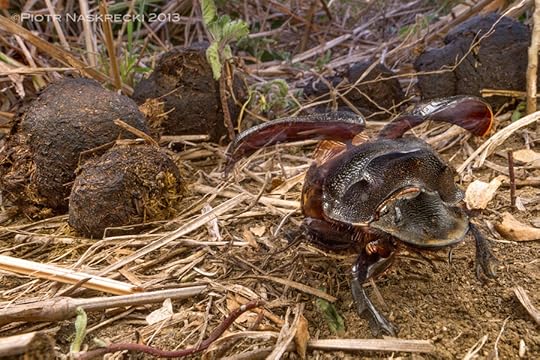
Female Heliocopris sp. taking off, apparently not satisfied with the quality of the dung she found.
Dung beetles are critically important members of savanna communities that dominate Gorongosa, and without them and their waste removal labor the place would quickly sink under layers of dung produced by thousands of mammalian grazers and browsers. Their ability to return nutrients trapped in dung into the soil also supports the positive feedback loop between rapid vegetation growth and herbivory. The ecosystem services provided by dung beetles thus carry actual, calculable monetary value – I am not sure what that value is in Gorongosa, but in the United States the dung removal services by beetles is estimated to save the cattle industry $380 million per year. In Australia dung beetles imported from Africa and other places saved the cattle industry from a total collapse after it became apparent that local insects were not adapted to processing manure of non-native mammal species; New Zealand is also considering a similar move to save itself from an ocean of cattle and sheep dung that threatens to engulf the islands.

Male Heliocopris andersoni, one of the largest and most impressive dung beetles in Africa.
But dung beetles are not only useful and pretty, they are also supremely cool – a recent study demonstrated that they are the only insects known to navigate using the position of the Milky Way and other galaxies. Only humans (and possibly a few other animals, but it has never been conclusively proven) use the position of celestial bodies to find their way around.
And although I quickly learned that I should hold my breath and discreetly reach for a bottle of hand sanitizer every time Bruno brought me a new specimen, it was always a thrill to see a new animal. The high dung beetle richness we found on the Cheringoma Plateau shows that Gorongosa is well on its way to full recovery, and its cleanup crew is alive and well.
A time lapse movie spanning 10 hours of dung beetle activity, showing what happens to warthog dung in Gorongosa. (Click here for a high quality version of the movie.)

Plum dung beetles (Anachalcos convexus) do not display sexual dimorphism, and both males and females form dung balls; this species is also often seen feeding on dead insects.
Filed under: Beetles, Behavior, Cheringoma, Gorongosa, Insects, Mozambique


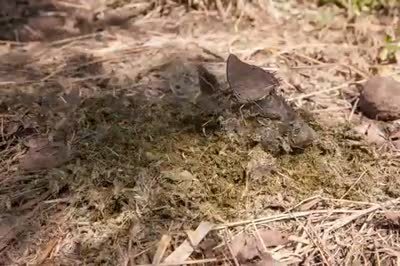
Piotr Naskrecki's Blog
- Piotr Naskrecki's profile
- 9 followers



